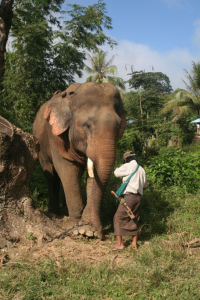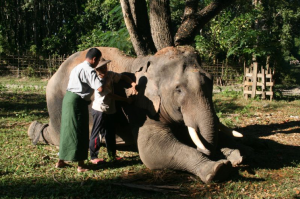Management of working elephants at Lake Indawgyi.
In the Lake Indawgyi Biosphere Reserve, we will take care of the management of working elephants from 2020. The project is supported by the World Animal Protection Society and is carried out locally in cooperation with the Burmese organization Grow back for Posterity (GBP). The project activities serve to improve the living conditions of many private working elephants in the biosphere reserve in the short term, directly and as quickly as possible.
The number of elephants kept there is estimated between 120-150 animals. All elephants kept in the project area are owned by private individuals from the region, none are owned by the state forestry companies. The animals are looked after by so-called mahouts (elephant handlers), who are employed or paid by the respective elephant owner. Elephant and Mahout are rented together for work assignments. Some elephants are not permanently on site, but are temporarily deployed in other regions.

In order to obtain an up-to-date overview of the situation and, above all, the health condition of the animals, a survey was carried out by Chances for Nature and FFI Myanmar in November 2017 together with the Academy for Zoo and Wildlife Conservation a first free health check was carried out, during which elephants not officially reported to the authorities were also registered with the conservation administration. Our project met with great approval from elephant owners and had a gratifyingly high response. Furthermore, the elephant owners expressed the wish for repetition of this action, as well as the wish for further training and knowledge transfer on the part of the state veterinarians.
Of the 34 animals examined and treated in the preliminary study, 20 were under 30 years of age, including 7 no older than 5 years. Both the exact total number and the number of permanent resident animals are uncertain to date. Many of the animals are involved in illegal forest clearing of the primary forest of the reserve. This should be prevented by registering all elephants.

The training of a working elephant is long and, above all, but from today’s point of view, quite brutal. The animals are subjected to massive force until the elephant’s will is broken and it submits to the mahout or oozie (translated from Burmese – “head rider”). At the age of about 4 -5 years this so-called breaking in begins. The animals are restrained with the help of ropes and chains and made docile with beatings, food and water deprivation. The Burmese way of breaking in and subduing elephants is based on a tradition that goes back thousands of years. However, new findings in the handling and training of elephants allow a much gentler and more animal-friendly way of keeping them, which we would like to implement there together with the elephant owners.
In the 2017 pilot project conducted by Chances for Nature e.V. in the UNESCO Lake Indawgyi Biosphere Reserve, veterinarians were also able to confirm numerous work- and husbandry-related health problems. Veterinarians employed on site as part of the project will look after the health of the animals and train local veterinarians, elephant owners and mahouts.
In the medium term, a modern species-appropriate husbandry, away from the traditional and brutal husbandry and training methods should be established. For this purpose, a central contact point in the form of an elephant care center is to be created. In the long term, this will then be developed into a permanent holding and information facility. Here, old and sick animals could also be accommodated and cared for on an inpatient basis, as well as educational work could be carried out and training offers implemented. The relevant preparatory work for this is to be carried out over the next two years.



